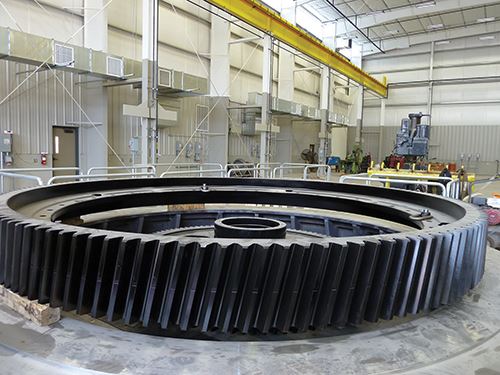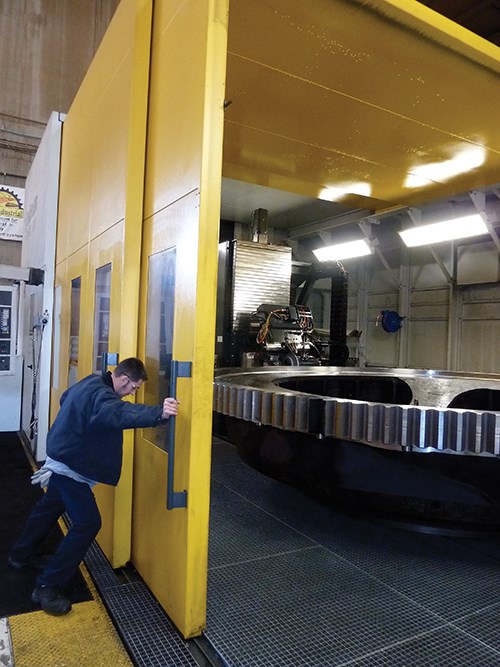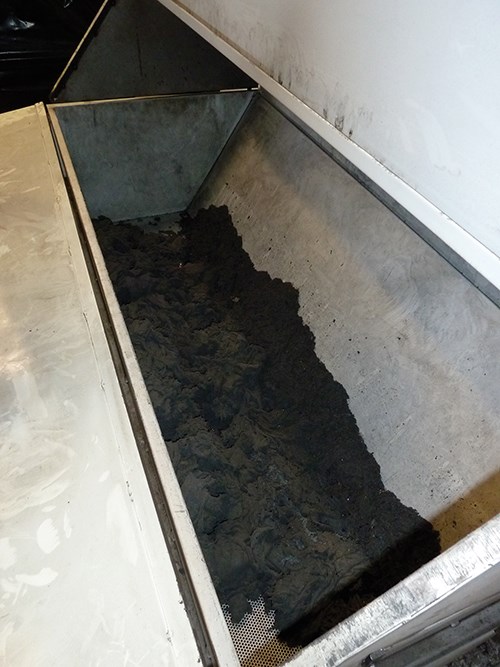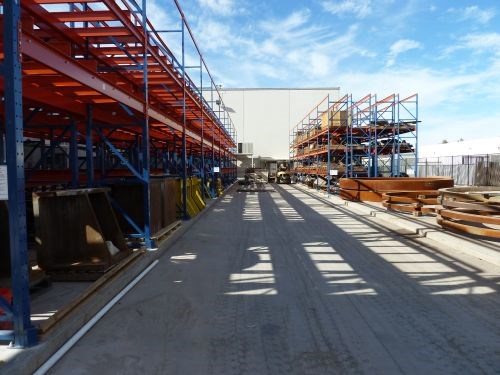Grinding Big Gears from Blanks
Harnessing the latest abrasives technology enables this shop to grind huge gears complete from blanks, eliminating multiple machining steps and providing a smooth surface finish.
Share






Hwacheon Machinery America, Inc.
Featured Content
View More
Autodesk, Inc.
Featured Content
View More

The larger the gear you’re producing, the less often you want to move it between machines. Ideally, you’d like to load the blank onto a machine, hit cycle start and then unload a finished part. Although it’s a little more complicated than that, this is now a reality for L&H Industrial in Tempe, Arizona. New abrasive technologies and equipment designs have made it possible for the shop to grind a gear straight from a solid—eliminating steps such as hobbing and shaping—in less time than was required using those methods. In addition, grinding provides a mirror-like surface finish right off the machine, allowing it to achieve a gear quality of AGMA 14 or higher.
As for big gears, they don’t make them much larger than those used in mining applications, according to Garrett Goldman, general manager. In order to handle massive gears sometimes measuring more than 20 feet in diameter, the company purchased a Höfler Rapid 6000 6-meter CNC profile grinder in 2013, working with Norton Abrasives to identify the best grinding wheel for its repair and production work. “Once the Höfler was installed, we began experimenting with grinding gear teeth straight from a blank, and it was a success,” he says. “With each passing month, we learn a little more about how we can get the most out of this investment and about the benefits of the grinding process as well.”
Gigantic Gears
Founded in 1964 as L&H Welding & Supply by Leon Wandler, the Gillette, Wyoming-based company specialized in oilfield equipment repair, later focusing on the mining industry. It has since grown to five locations throughout the U.S.—additional facilities are found in Canada, Mexico and Chile—with the Tempe operation devoted specifically to gearing. About half of its gear work involves repairs to shovel, dragline and drilling components, with the rest devoted to manufacturing ready-to-ship aftermarket parts. “We produce everything from 12-inch pinions to gears more than 200 inches in diameter,” Mr. Goldman says. “The largest gear we’ve run across our grinder so far was 243 inches in diameter, in fact.”
Prior to purchasing the Höfler grinder, gear production involved pre-gashing on a specialized machine, then hobbing and shaping, requiring multiple moves and repeat setups. The decision to make the investment involved the desire both to simplify this process and to have a backup plan for busy periods.
“We initially intended to use the machine for finish grinding and to have a way of getting gears out the door when other equipment was tied up or down for maintenance,” he says. “As we grew more familiar with the machine, though, we started thinking about ways we could really explore its capabilities in terms of what we could accomplish without pushing it too hard and causing unnecessary wear.”
Rory Tagle, a longtime employee who spent nine years working in his father’s gear shop in Texas before joining L&H, took the lead on learning to program and operate the machine. Accustomed to working on manual equipment, he welcomed the opportunity to step up to CNC machining and has taken full advantage of the training the Höfler engineers have provided.
“They have visited us here for hands-on training, and I’m in constant contact with their engineers in Germany,” Mr. Tagle says. “For instance, whenever we mount a large workpiece on the grinder, a Höfler engineer will access our controls and help calibrate the machine before we begin grinding the teeth. The engineer can’t take full control of the machine for safety reasons, so we work together at this stage of the process.”
Such a scenario was occurring on the day of my visit, in fact, with the engineer monitoring the controls of the huge Höfler from his office in Germany and communicating with Mr. Tagle via onscreen text boxes. The 206-inch-diameter gear rotated slowly on the worktable, coordinates displayed on the control monitor were adjusted, and only when a passing grade was issued on each step would the virtual operator signal that it was time to move on to the next.
Mr. Tagle says this calibration is required for gears weighing 50,000 pounds or more, or measuring larger than about 170 inches in diameter. “The engineer is looking at the mass and motion of the workpiece, making sure that it will stop in the right position for the wheel to make contact,” he explains.
“The last part we had on the grinder before we loaded this gear was a tiny 17-tooth pinion, so the machine was tuned for that and had to go straight to work on a 90,000-pound gear. In fact, when I’m setting up a big gear, I’ll go ahead and email Höfler so they’ll know what I’m doing and be ready to help adjust the settings for that job, which really doesn’t take very long.”
As with any machining process, however, the right tooling had to be determined for the machine to deliver its full potential. While the wheels provided standard with the machine did a good job, they were suited more for finishing operations than for significant material removal. Mr. Tagle was seeking both, and that’s when opportunity came knocking.
Applied Abrasives
As an application engineer at Norton Abrasives, Phil Plainte along with his colleague David Graham, from the company’s R&D center, work together to create new technologies that meet the requirements of the ever-evolving manufacturing industry. In the Higgins Grinding Technology Center (HGTC), located in Northboro, Massachusetts, Mr. Graham develops products and processes for customers in various industries. As new grinding equipment designs are introduced, along with new materials and increasingly complex part geometries, he develops new products on the grinding equipment in the HGTC lab. Subsequent to this technology being tested, it is applied in the field. Advanced wheel grain shapes, formulations and bonds must be developed, as well.
At the very time when a new abrasive wheel was being developed by Norton for the powerful new grinders coming on the market, Mr. Plainte received a call from Scott Bradley, area manager at L&H, who asked for his assistance. “He told me that they had purchased a Höfler Rapid 6000, of which there are only a few in the country, and that they wanted to make sure they were using the right grinding wheel,” he says.
“I saw an opportunity to work together on the development of this new wheel, with L&H acting as the real-world beta tester for wheels that we would provide.” Mr. Plainte would personally oversee the project, making site visits to Tempe, testing the Norton wheels on the grinder with Mr. Tagle, and then reporting his findings to the R&D lab for adjustments to the formulation.
After a preliminary visit to familiarize himself with the company and its capabilities, Mr. Plainte returned with a selection of test wheels. An indication of the many factors to be considered became apparent during the first test, involving an NQX wheel. “In terms of material removal, it was just outstanding,” Mr. Tagle recalls. “But the swarf it produced kept clogging up the machine. It was like a fine steel wool, very dense, and the buildup was actually a fire hazard since it was saturated with oil coolant. So that one didn’t work out.”
Success came quickly, however, with a wheel that combined the very traits L&H was seeking: robust material removal and a polished, repeatable surface finish. The TGII extruded grain wheel features a long, thin grain that resembles pasta or rice, with an aspect ratio—length to width—of 8-to-1. These grains are loosely packed, with the spaces between them maximizing material removal and coolant retention. They stand up to the high force inherent in high metal removal rate processes. Wear resistance is good, and the swarf the wheel generates passes easily through the grinder and exits the machine to be processed.
Apart from all the time saved eliminating setups required when moving a gear from a gasher to a hobber and then to the grinder, Norton’s side-by-side comparison of hobbing versus grinding shows that cutting times can be slashed in half.
Mr. Plainte describes a gear made of 4140 alloy steel with a hardness of 28-32 HRc, a tooth depth of 0.438 inch and length of 7.25 inches, and 80 teeth in total. Using a carbide 2 start hob, the total cutting time was eight hours. With a TGII abrasive wheel, total grind and dress time came to four hours. By using a systems approach—which takes the abrasive, the work material, the machine and process conditions into account—the research concluded that grinding is a cost-effective alternative to hobbing and shaping, producing removal rates of 7 cubic inches per minute per inch.
Mr. Plainte says that job shops, large gear makers, maintenance and repair facilities, gearbox rebuilders, and producers of specialty gears should consider grinding for a variety of reasons. These include lower cost, fewer setups, competitive cycle times, reduced tooling inventory and the ability to respond quickly to customers’ needs.
“No matter what type of operation it is, though, there are certain things that an operator must keep in mind in addition to choosing the right grinding wheel, such as proper coolant application, keeping the wheel face clean with scrubber nozzles and using a quality oil coolant,” Mr. Plainte says. “And of course, you need a machine that’s both stiff and powerful, but that’s certainly not a problem with the grinder that L&H has chosen. It’s a monster.”
Strategic Streamlining
The beauty of that beast is becoming more apparent over time, according to Mr. Tagle. To date, L&H has used the Höfler to grind more than a dozen gears complete from blanks. He has learned plenty along the way.
One lesson involves the difference between rough and finish grinding. “You need to dress the wheel more often when you’re rough grinding,” he says. “By doing that, you hold a better tooth form, because the wheel’s surface can become distorted due to wear and material buildup.”
Another has to do with heat treating. When grinding a gear complete from a blank, heat treat occurs between the roughing and finishing processes. During the roughing phase, the operator must determine how much stock to leave in place, depending on whether the gear will be carburized or induction hardened, as these and other tempering procedures have different requirements. The gear is then returned to the grinder for finishing.
This is yet another benefit of the grinding process, according to Mr. Tagle. “You can’t take a gear straight from the pre-gasher to heat treat, because the cut is so angular, and it really isn’t a true tooth form yet,” he says. “So if you roughed out your teeth on the pre-gasher, you’ve still got to put it on the grinder before going to heat treat. But when you’ve roughed out the teeth on the grinder, the gear is ready to go in the oven before it’s returned to the grinder for finishing.”
As for gear forms, Mr. Tagle says it’s all a matter of programming. “To be honest, you can grind anything from the smallest, skinniest tooth up to the widest and deepest tooth and it doesn’t matter,” he says. “The machine doesn’t know the difference. Obviously, the more material you have to remove, the longer it will take, but the machine approaches the work in the same way regardless of the size or geometry of the gear.”
On the day I visited L&H, the scenario Mr. Goldman envisioned when considering purchasing the grinder had actually occurred when the company’s pre-gash machine—which was custom-built in the late ’70s—broke down with a gear on the worktable.
Interestingly, it’s the very gear pictured in this article.
“It wasn’t a rush job, so we had some time to come up with a solution, but a month after the pre-gasher had broken down, we still didn’t have it running,” he says. “Lucky for us, we have a backup plan now. We ended up moving the gear from the pre-gasher to the grinder to complete the job. The pre-gasher had only cut three teeth when it went down, so there were 37 left for the grinder to rough out. The only challenge we faced was the time we lost moving the gear and setting it back up again. Apart from the transition between machines, having the grinding pick up where the pre-gasher left off went very smoothly. Once we had everything dialed in with the help of the Höfler engineer, we were back in business.”
Leading Edge
Having the grinder changes the equation in terms of equipment usage and workflow, Mr. Garrett says. A recently completed 23,916-square-foot expansion will house the company’s welding shop and provide new office space, allowing the relocation of existing machines to improve efficiency and material handling.
“Now that we have the grinder, we can factor its capabilities into how we go about doing things and look for machine configurations that streamline how each job progresses through the shop,” he says. “We still want to get everything we can out of our older equipment, such as the pre-gasher, but it’s always important to have a plan B in place in case something goes wrong. Now we’re prepared for that, and we’re also at the forefront of current gear-grinding technology. And that’s a good place
to be.”
Read Next
Building Out a Foundation for Student Machinists
Autodesk and Haas have teamed up to produce an introductory course for students that covers the basics of CAD, CAM and CNC while providing them with a portfolio part.
Read More5 Rules of Thumb for Buying CNC Machine Tools
Use these tips to carefully plan your machine tool purchases and to avoid regretting your decision later.
Read MoreRegistration Now Open for the Precision Machining Technology Show (PMTS) 2025
The precision machining industry’s premier event returns to Cleveland, OH, April 1-3.
Read More












































.jpg;maxWidth=300;quality=90)








